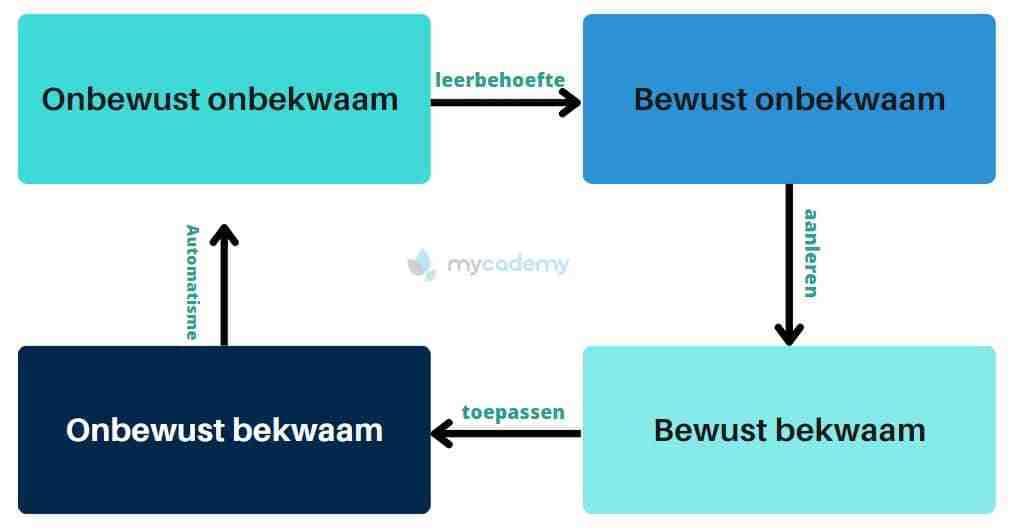Maslow's learning curve: a complete explanation
As a self-employed person, do you want to expand your knowledge and effectively learn a new skill or competence? Then be aware of the steps you take in doing so. After all, there are different ways of learning, for which learning models have even been developed. One of the best known: Maslow's learning curve.
Maslow's learning curve describes different stages you go through when learning a new skill. Maslow divides this into four different stages, each representing a unique point of where you are within the learning process.

Unconscious incompetence
The first stage within this process is christened as unconsciously incompetent. This means that you are not aware of the depth of knowledge behind a particular skill. In this case, you are therefore unaware of the lack of knowledge you currently have.
Consciously incapable
After this comes the moment of realisation that you don't actually know that much about the subject after all and accept that you still have a lot to learn. When you get this realisation, you have a better idea of what you can still learn and recognise the specific parts of the particular subject in which you want to specialise or develop. This way, you can be more focused and precise when it comes to gathering new information.
This is a turning point in the learning curve for many people, because you now find out that what you wanted to learn turns out to be more difficult than you thought. You either throw in the towel or take up the challenge with new motivation. In the latter case, you delve deeper into the subject matter before reaching the next phase.
Consciously competent
When you finally start to feel a little bit at home in the subject but still have to put a lot of effort into this skill; that's when you become consciously competent. You are no longer a layman within this subject, but it still takes some effort and time to be able to do it to some extent. This means that you still need to concentrate well when performing this. Once you get here, it will still require a lot of energy to do ZZP tasks and actions well, and mistakes can still be made easily.
Unconsciously competent
If you have done well in the first three stages, at some point you will arrive at stage four: unconsciously competent. This means that you easily complete actions and tasks without thinking too much about it. You don't necessarily stop to think about the fact that you have already become competent in this field; it happens unconsciously and it all feels natural.
In fact, at this stage, you are almost learned within this subject. The advantage of this is that performing the actions is fluent and often almost flawless. The downside, however, is that it is difficult to teach this skill to someone else because you no longer think about all the actions you perform and are therefore no longer aware of how the learning process works.
How do I apply Maslow's learning curve?
If you want to teach a new skill or competence in the most effective way, you can use the following roadmap:
- Identify what you want to learn. Create for yourself a clear and distinct picture of exactly what you want to learn, so that you don't lose yourself in the sea of information involved. Often a lot of information is irrelevant to what exactly you want to learn or achieve. The clearer the objective, the easier it will be to find specific information that will help you learn the desired skill.
- Acknowledge your lack of knowledge. When you start immersing yourself in a new subject, it is crucial to be open to learning. If you think you already know, it is harder to take in new information. Therefore, you need to acknowledge that you don't know much (or anything) about the subject yet. Accept that you still have a lot to learn and see it as a challenge, not an obstacle.
- Find resources for learning that suit you. Not everyone likes to gather information in the same way. Therefore, check with yourself which way of learning suits you best. Do you prefer reading books, studies and white papers or do you prefer watching YouTube tutorials? Or perhaps a more personal approach with a tutor or a training course is more to your liking. The right choice around this topic can make a big difference in how fast you develop within this skill.
- Practice, practice, practice. Keep challenging yourself and keep practising to get better at the job. Even if you occasionally achieve a desired result effortlessly, this does not mean that it is always that easy. The trick is to keep motivating yourself and not be too quick to think you are already there and can now sit back. Regularly ask for feedback from people who are also in the profession or skilled within this skill so that they can teach you new things if necessary.
Getting started through HeadFirst
The beauty of this learning curve from Maslow, is that you can apply it anywhere; from work to sport and other pursuits. For anyone interested in self-development and personal growth, this model is a great thread to gauge your learning.
If you are a professional working for a client through HeadFirst, you can get access to the learning platform Striive Academy to expand your knowledge and skills. Click here for more information.
- Find a suitable assignment
- Place a bid
- Simple contract processing
- Getting Started
- Fast disbursement
